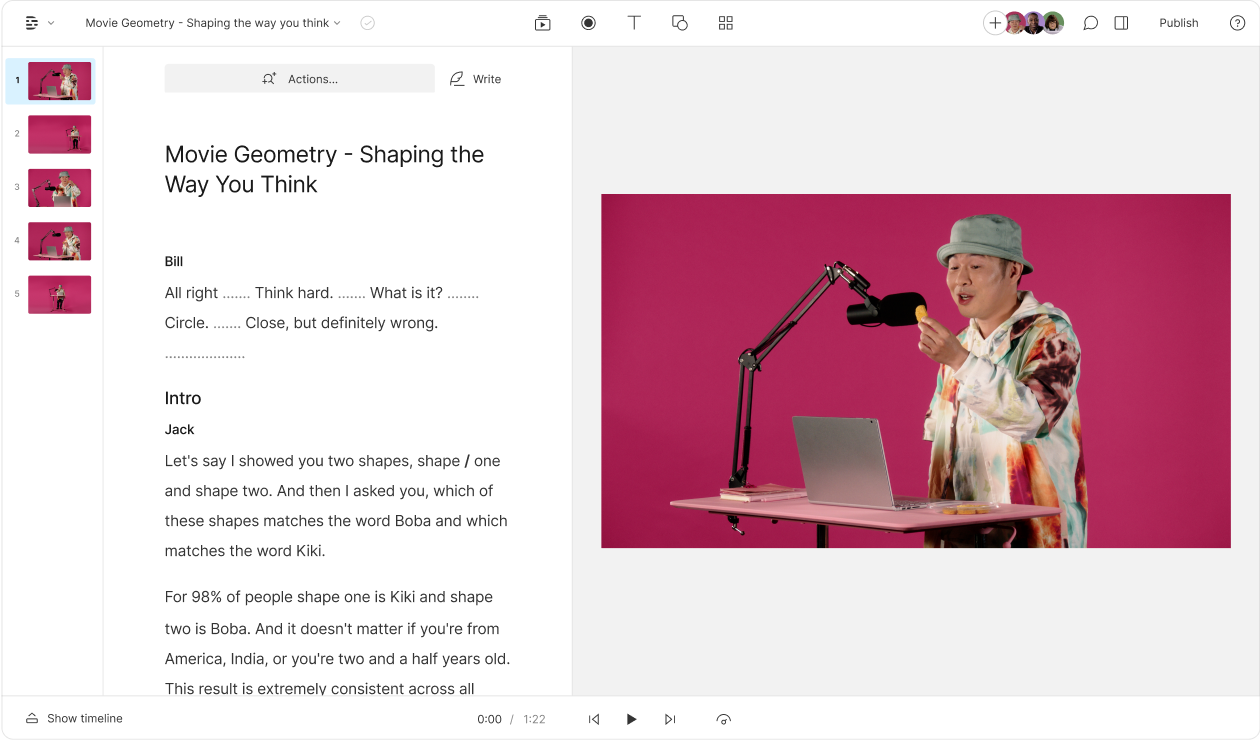What type of content do you primarily create?




Your podcast might be missing half its potential audience if you're audio-only. Nearly half of podcast listeners say they prefer to consume them with video, according to one survey. YouTube, in particular, is one of the most popular places to consume podcasts.
The jump from audio to video isn't just about pointing a camera at your microphone, though. Even seasoned audio pros can stumble into video pitfalls they never knew existed. Let's explore these common mistakes—and more importantly, how to fix them.
Understanding video podcasting and why it matters
Video podcasting is basically an audio show with a camera in the room, letting you expand your audience to watchers who appreciate the extra visuals. When you record in video, it’s not just about lip-reading or fancy overlays—it’s about building deeper engagement by letting viewers see your expressions [research]. According to the research, leveraging video podcasting can broaden your visibility, especially on platforms like TikTok and Apple Podcasts. Plus, having a friendly face to associate with the voice can help viewers feel more connected to your show. It’s still a podcast at heart, so don’t go overboard on glitzy visuals if they distract from the main conversation.
Video quality issues when adding video to your podcast
Your video gear doesn't need to be super high-end, but it should be a step-up from your grainy laptop camera. Whether you're filming your video podcast remotely on a platform like Descript, or shooting in-person, make sure your video meets some basic professional standards. With Descript's Rooms feature, you can record remote conversations in up to 4K video quality, giving your podcast a polished look from the start.
Here are some video-quality "don'ts" when adding video to your podcast:
- For remote podcasts, don't record in Zoom or Google Meet. The footage will include all the compression and lag you get with streaming video.
- Don't let you or your guests sit with a bright window behind them. Unless you've got the lights to compensate, you'll see a blinding background and a person in shadow.
- Similarly, don't sit flush against a wall. A plain background might sound appealing, but you want some space between you and your background.
- Don't let your guests show with stacks of boxes or dirty dishes behind them. It should go without saying, it will be distracting and terrible.
How to improve your podcast video quality
Here's a good example of a professional-looking, remote video podcast: Tom Scott's Lateral, where a rotating group of guests answer weird questions with fascinating answers. Scott has a rotating group of guests (mostly other creators) join via video call. Guests have a variety of set-ups, from budget-friendly to professional cameras and microphones. But everyone looks and sounds good, which is essential for maintaining viewer engagement across platforms.
Here are some basic ways to fix a video podcast that looks a little too DIY. Descript's Studio Sound feature can help by removing background noise, eliminating room echo, and enhancing overall audio quality for your dialogue with just one click.
- Invest, at the very least, in a good webcam. If you have the budget, you could also invest in a proper camera.
- Instead of screen recording a Zoom call, try using a platform like Descript's Rooms, which records in high-resolution 4k and captures locally to avoid the lag and compression issues you get with streaming video.
- Take the time before an interview to scope out your guest's home or office. Can they move around so their face is well-lit, and their background looks professional — or at least, tidy?
- If you've got the budget, consider mailing a basic filming set-up to your guests. It might include a basic webcam and USB microphone. Unless you've got a huge budget, make sure they send it back.
- Some might consider ditching the “remote” part of their podcasts altogether. In cities around the US, ready-to-film studios come equipped with professional microphones and professional-quality backdrops. Some provide (or require) an in-house engineer to keep everything running smoothly. These spaces are usually rented by the hour, and prices vary widely by area.
Choosing the right equipment for video podcasting
You don’t need to break the bank for high-end gear; a decent webcam like the Logitech C920 or a solid smartphone camera can do the trick. Still, it’s worth upgrading if you want crisp visuals that stand out on YouTube, especially for product demos or guest interviews. Don’t skimp on lighting—a ring light or softbox can transform your dim, definitely-not-a-movie-set space into something watchable. The biggest pitfall is poor audio, so invest in a reliable mic such as the Rode NT-USB or the Shure SM7B, and keep echoes at bay with a quiet room or basic soundproofing [research]. Getting all this right from the start spares you from re-recording sessions or apologizing for fuzzy visuals in post.
Video editing mistakes to avoid in your podcast
You don't want to make the video podcast feel like an afterthought. The visual dimension of your podcast is an opportunity to, literally, show instead of tell. When recording remotely, Descript's Rooms feature allows for multitrack recording, making it easier to capture high-quality video from each participant.
Video editing "don'ts" when creating your video podcast:
- Don't sit on a single shot for the entire episode. You could opt to use the same frame for the entire show, like a grid of speakers (which is the default for most multicam recordings). Not only is this visual boring, it makes your edits glaringly obvious. Cutting between cameras can be tedious — unless you use Descript's Automatic Multicam, which does it for you in seconds.
- Don't skip complementary visuals. In-person podcasts with high production value might skip B-roll entirely, but the lower quality of remote interviews can really benefit from cutting to other visuals. It's often that podcasters find themselves discussing clearly visual topics: a photograph, a viral video, a news clip, a social media post, and so on. Putting that on screen will not only add visual interest to your podcast, it can cover up awkward edits.
- Don't skip burned-in subtitles, especially for short clips. While they may not be standard for longer-form videos, burned-in subtitles are standard on platforms like TikTok.
How to edit your video podcast professionally
Colin and Samir's podcast gives a good standard for good multi-camera editing and complementary visuals. Notice how the intro is more visually rich than the rest, likely an effort to put in more work where the most viewers are likely to be watching. With Descript's Automatic Multicam feature, you can automatically switch between camera angles to keep the active speaker on screen, saving hours of tedious editing work.
Here are some more common fixes for improving your video podcast quality:
- Many remote recording services like Rooms provide individual files for guests, allowing you to edit between full-frame shots of individual speakers, or shots of multiple guests at once. And again, Descript'ss Automatic Multi-cam will do the work for you.
- Descript offers an easy captioning tool that lets you pick the font, color, and size of the text, then apply it to your video with a click.
- Take note of how Colin and Samir pull in visuals of relevant creators and videos when discussing them. Take the time to search for visuals—B-roll, photos, other graphics, that represent topics covered in your show.
Choosing the right platforms for your video podcast
Where is your video podcast going to live? On YouTube, TikTok, LinkedIn? There are nuances to each platform, not only around what kind of content does well, but what the standard podcast format should look like. For 2025, video podcasts on YouTube typically perform better at 1080p resolution, though Apple Podcasts supports up to 4K video.
Most importantly, no matter where you publish: Don't try to shoehorn an audio-podcast format onto a video platform. For example, you may need to do a gentle re-edit of the audio. Sound effects ported over to video may feel out of place all of the sudden. A musical interlude may be too slow for the fast-pace of YouTube. Descript's editing tools make it easy to adapt your content for different platforms, letting you create platform-specific versions from a single master recording.
The platform "don'ts" when publishing your video podcast:
- Don't include long intros that will lose viewers on video platforms.
- Don't upload your podcast “as-is” to a new platform.
- Don't forget clips. Long podcasts that zig and zag through different topics are the norm in audio. However, finding clips of the appropriate length for YouTube, TikTok and so on have the potential for reaching a larger audience. These clips tend to perform better when they have a singular focus: they might relay an important piece of information, or tell a single compelling story.
How to optimize your podcast for different platforms
Take note of what video podcasts in your space are doing well on the platform you'd like to post on. How long are they, how are their intros structured? Understanding platform-specific best practices is crucial for reaching your target audience effectively.
While there are many, “Conan O'Brien Needs a Friend” does a great job of adapting to each platform. Full episodes are posted on YouTube, while short clips get their own titles and hooks for platforms like TikTok.
- Re-edit your podcast into platforms like YouTube, keeping an eye for what will pair well with an enticing thumbnail and title.
- Also consider breaking up longer episodes into their own discrete videos.
- Consider also editing in a cold open or a quick montage to establish the content of the episode.
FAQs
What are the typical costs of a video podcast?
The initial expense can range from a few hundred to several thousand dollars depending on the quality of the cameras, microphones, and lighting you choose [research]. If you opt for a simple webcam and a basic USB mic, you can certainly keep costs on the lower side. More advanced setups—like a professional camera, a solid audio interface, and studio lighting—will push your budget higher. Free or low-cost editing tools, such as iMovie or DaVinci Resolve, can help keep post-production expenses down. Ultimately, it’s about balancing production value with your show’s goals.
What’s the difference between a video podcast and a vlog?
A video podcast generally follows the structure of a traditional podcast, focusing on topics or interviews, but with the added benefit of a camera rolling [research]. Vlogs, on the other hand, tend to be more personal, featuring day-in-the-life updates or narrative-driven content. Video podcasts are often distributed on podcasting platforms and YouTube, while vlogs typically live on social media channels. One isn’t inherently better than the other—it all depends on your content goals. If you want a more casual, personal style, go the vlog route; if you prefer a structured show, video podcasting might be the way to go.


























%201.svg)













